The Samsung Galaxy S7 and S7 edge Review: Part 2
by Joshua Ho on July 5, 2016 8:00 AM ESTSystem Performance Cont'd
Now that we've gone over the more general purpose system benchmarks we can focus on new benchmarks that emphasize GPU performance much more strongly. For the most part we haven't had huge issues here like we've had with good CPU and general performance benchmarks, but it's important for us to keep our benchmarks up to date in terms of workload balance and overall performance.
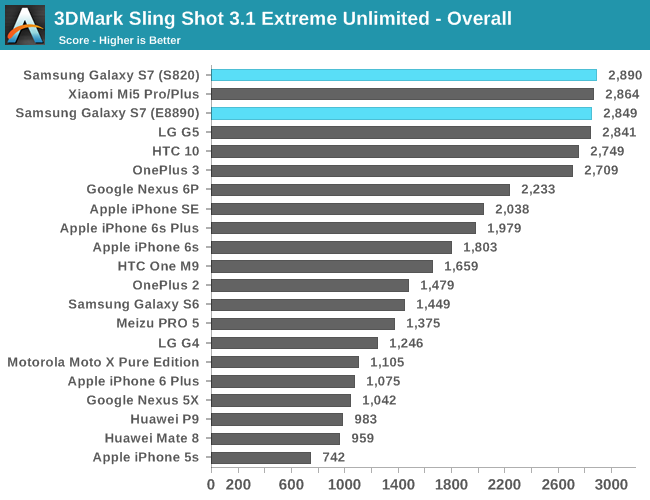
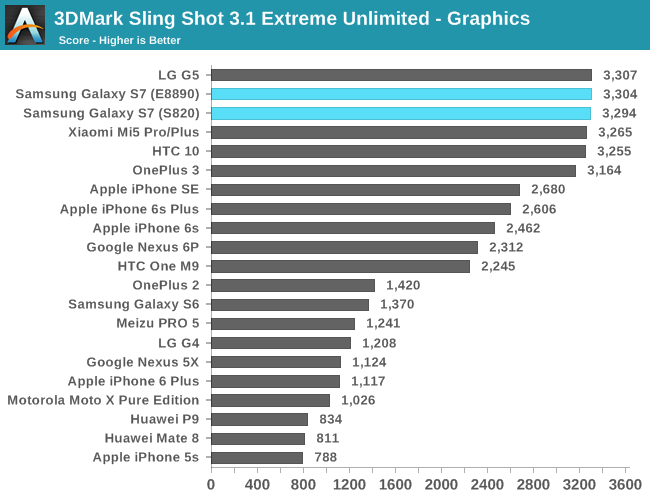
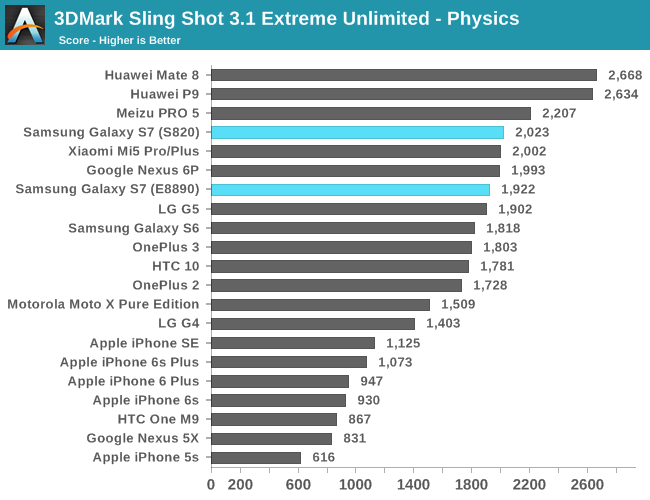
One of our first new benchmarks designed to better test the GPU is 3DMark's Sling Shot ES 3.1 test, which is designed to test a GPU's performance when the application is either using OpenGL ES 3.1 or Metal. As one can see, the Snapdragon 820 and Exynos 8890 have basically comparable GPU performance in this test and in the physics test as well. Once again we're seeing how core count and clock speed are basically the primary determinants of performance in the physics test when the device isn't strongly limited by thermals. I wouldn't draw any real conclusions from this as generally game CPU code can extract ILP unlike what we're seeing in this test.


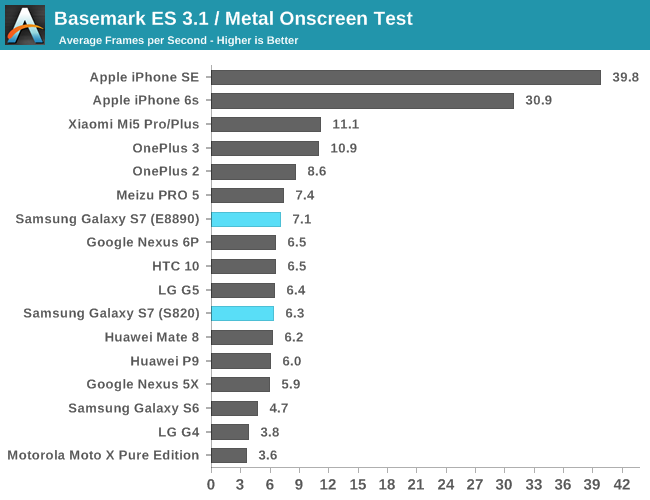
In this test we start to see that the Mali GPU in the Exynos 8890 and the PowerVR GPU in the A9 are providing a noticeable advantage over the Snapdragon 820's Adreno 530 to a noticeable extent.

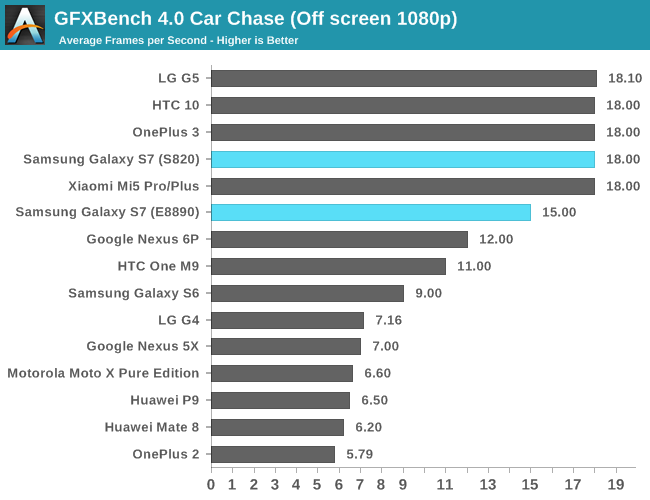
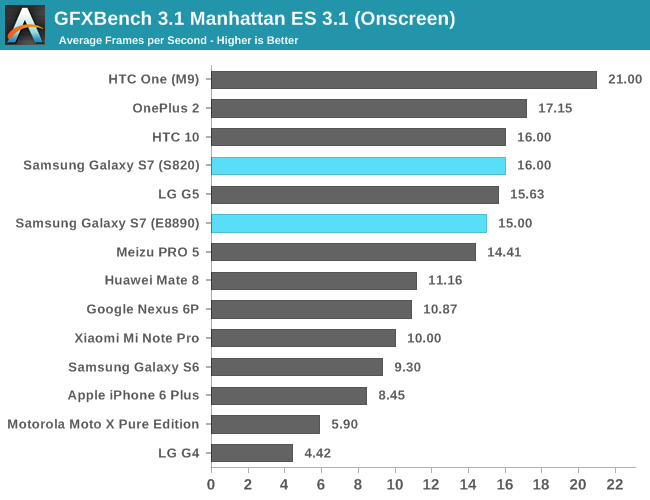
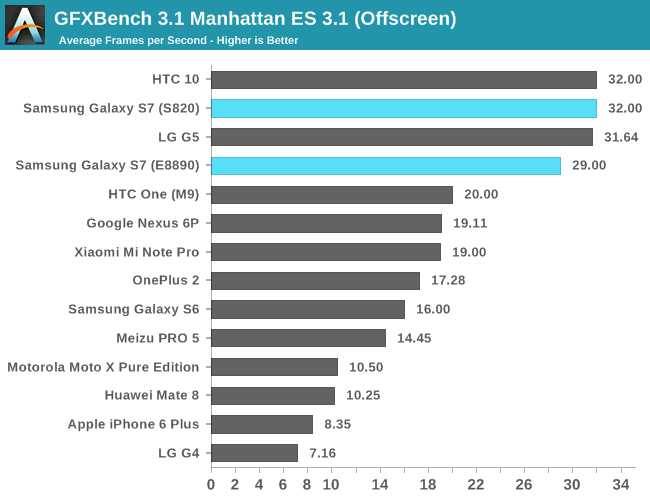
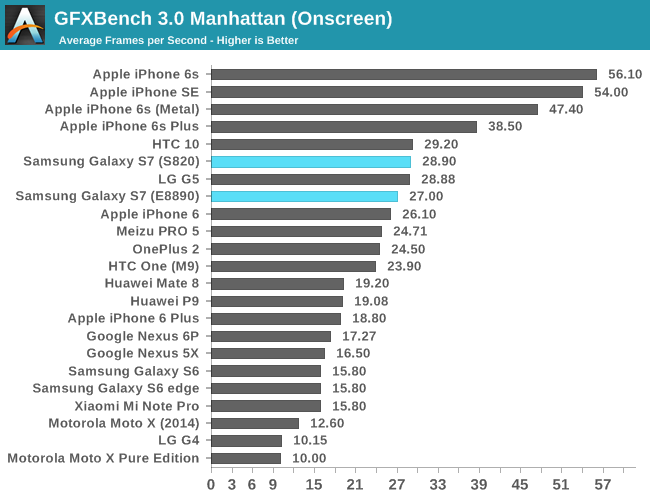
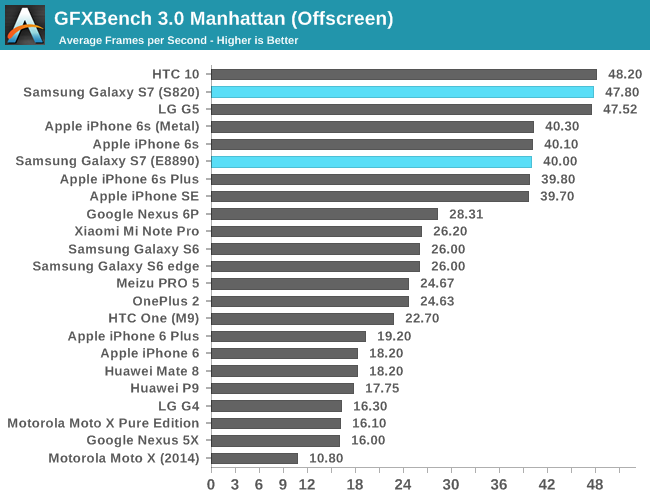
With GFXBench we can see that in Car Chase and Manhattan the Adreno 530 actually manages to pull away. However, because we have basically zero architecture disclosure on the Adreno 530 there's really no way for us to explain what's going on here and why. The reasons for the difference in performance could be related to drivers or architecture or architecture implementation and in the absence of information it's probably best to avoid making blind guesses. Regardless of these details, the Snapdragon 820's GPU should be more than enough for playing the latest games, but unless you use Samsung's automatic game optimizer system to set render resolution to 1080p it won't do as well as the iPhone 6s but given that most Android games target a much lower spec level it's likely that you won't have any problems given that the Adreno 530 is on the bleeding edge for Android SoCs.










266 Comments
View All Comments
Michael Bay - Wednesday, July 6, 2016 - link
Somebody hasn`t lived in the nexus times then.more-or-less - Wednesday, July 6, 2016 - link
What has nexus got to do with themes?? your statements make no sense at all.Impulses - Thursday, July 7, 2016 - link
I don't get it either, and I have a Nexus 5... Shouldn't a theme just be a replacement of a series of textures and color profiles that are basically static and loaded just the same regardless of how they're tweaked?I found the comment by Joshua kinda suspect too, maybe I'm missing something, BUT I don't see how themes really help with Samsung's UI foibles either.
You might get rid of their color choices, at best, but it does nothing for all the substituted apps and extra UI elements you can't alter (never mind background processes and optimizations); those are the bigger issue with TouchWiz.
JoshHo - Thursday, July 7, 2016 - link
I'm not sure what exactly was done in the Android theming system but somehow some third party themes have noticeable effects on performance.Artmi$$ - Wednesday, July 6, 2016 - link
excuse me but where is the HTC 10 complete review ???retrospooty - Friday, July 8, 2016 - link
HTC 10 review? That isnt made by Apple, it wont come until 2017, if at all.lopri - Wednesday, July 6, 2016 - link
How AT can publish this low quality review after such a long wait is beyond me. It is almost as if the author, after many (justifiable) criticism directed to him, had decided to stick it up to readers in defiance.So very disappointed. Sort of editing and quality control by a seasoned reviewer is warranted, IMO.
R. Hunt - Wednesday, July 6, 2016 - link
Anandtech is slowly fading into irrelevance, this review being perfect proof of it: too late to matter, content not really warranting the long wait.ntp - Wednesday, July 6, 2016 - link
The Gear VR received no mention even though it's the best mobile VR and games like Anshar Wars 2 are insanely fun in multiplayer.The Vulkan API deserves at least some words, since it will increase performance significantly when proper implementations will come out.
Waterproofing adds considerable value also, since it can make the difference between buying a working phone or a brick.
And regarding cameras, how can you even compare Apple's F2.2 with F1.7?! They are in completely different leagues yet I see no mention of the advantages Samsung brought by having the fastest lens of any phone: lower exposure times (less handshake) or less noise. If you'd have used a DSLR camera you'd know that the F number is basically what you pay for in a lens, all other things being the same.
This is not a biased review. It's just... unprofessional. Too bad it took AT so long for something so incomplete.
Impulses - Thursday, July 7, 2016 - link
There's a heck of a lot more to a DSLR lens than aperture, specially if you're not chasing shallow DoF (which a phone can't manage in most circumstances).f2.2 vs f1.7 is actually 3/4ths of a stop, which isn't nothing but it's not like night and day either... It means shooting at 1/40 vs 1/80 or less than one ISO stop higher.
Nevermind that very often the f stop lies and it's not a true measure of light transmission, since it's merely and literally a ratio representing a physical iris measurement.
Glass coatings and other factors can affect actual light transmission, which is why cine lenses have more accurate T stops... Then you gotta figure in sensor size and efficiency, etc etc.